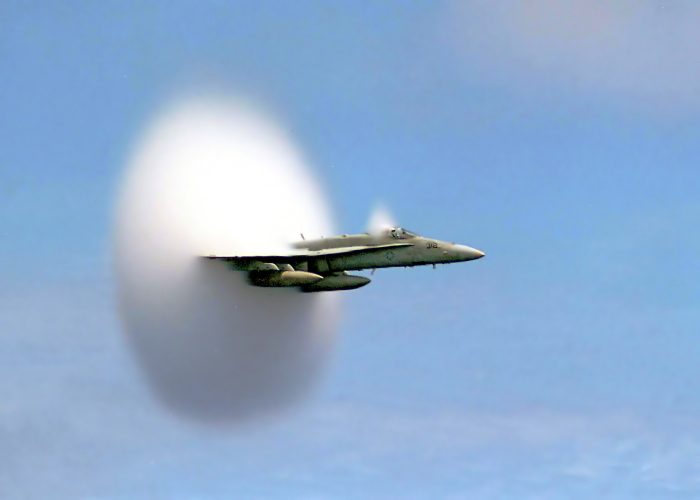Can you make a shock wave of light by breaking the light barrier just like supersonic airplanes break the sound barrier?
The answer to this is twofold, because it can be answered both yes and no. It depends on the material that you are in.
Can anything travel the speed of light?
Yes, particles that are considered quantum objects like photons can travel the speed of light, but they have no mass.
In order to stop thing from travelling into the past, thus preventing the universe as we know it from exploding, nothing can travel faster than the speed of light in a vacuum, or c in an equation.
Can anything break the sound barrier?
Supersonic airplanes are able to break the sound barrier when they fly faster than the speed of sound. The only reason that this is possible is because sound is simply vibrating air molecules traveling through the air.
When these airplanes are approaching the speed of sound, there will be a build-up of sound waves that pile up into a wall of pressure. Airplanes that are strong enough will are able to actually pierce through this wall of pressure.
This then causes a shock wave that will end up trailing behind them. This trail is what an observer on land would hear as the sonic boom.

Could this happen with light then?
If we take a spaceship for example and have it travelling near the speed of light and then accelerating past the speed of light, hypothetically, there would be a similar boom but with just light.
In other words, it would create a shock wave that is made up entirely of light. But nothing with mass can travel the speed of light in a vacuum, therefore a spaceship could never reach the speed of light unless there was an unlimited input of energy, which is impossible.
Therefore, a spaceship can never travel fast enough to break through the light barrier.
Why not?
This is not a matter of failed or bad engineering on scientists’ part. But it is more of a matter of fundamental physics. An object with mass cannot reach the speed of light because, as it approaches c, it would need an increasing amount of energy in order for it to keep accelerating.
This is something that has been verified on a smaller scale with particle accelerators.
What is a particle accelerator?
A particle accelerator will use electrical power consumption equivalent of small town and channel that energy into simply getting a few particles like electrons or protons to travel extremely close to the speed of light, c, in a vacuum.
These machines are being improved upon every year and reaching higher speeds each time. In fact, within the span of a decade, the particles were reaching speeds from 99.99% the speed of light to reaching 99.999% the speed of light. In the space of ten years that is quite impressive.
More recent readings show that the particles have been able to reach up to 99.999997% the speed of light. That is a significant improvement.
Is this just in a vacuum, though?
Yes, all of this science up to now refers to light and the speed of light in a vacuum. Things change when you are not in a vacuum because there are other factors to consider too.
When light is travelling through a different medium like glass or water, it is slowed down so that it is no longer c, the speed of light in a vacuum.
What does that mean for objects travelling the speed of light then?
If you consider something travelling in water at the same speed that light can travel in water, this is possible since there are no fundamental laws being broken. The reason no laws are being broken is because c, the speed of light in vacuum, is no longer useful in this scenario.
This does mean that an object travelling faster than the speed that light can achieve in water will actually cause an optical shockwave. So, technically, an object can travel faster than light, but it depends on the medium that it is travelling in.
What is this called?
This effect, or an optical shockwave, is called Cherenkov radiation. It is only visible with the naked eye if the object is travelling extremely quickly and through quite a dense material.
Nuclear reactors will spew out electrons at high speeds, since these are by-products of the very same nuclear reaction. Interestingly, these electrons travel faster than the speed of light in water, causing shockwaves of light.
There is a strange blue glow to the Cherenkov radiation which is quite eerie.
Isn’t air a vacuum compared to water?
No. Air is very close to being a vacuum but it will never be a perfect vacuum. For this reason, the speed of light in the air around us is slightly slower than the speed of light in a vacuum, or c.
This means that it is technically possible for something to break the light barrier in regular air without breaking fundamental laws and limits of the speed of light in a vacuum.
But you are not as likely to see the blue glow of the Cherenkov radiation in air than you are in water. This is simply because you would have to travel faster in air than water, since water is a denser medium, so the speed of light is slower.
That is not to say that it never happens in air though. We can actually see examples of this from earth. When a supernova shoots out particles at incredible speeds (but still less than c), they will reach earth’s atmosphere and will be known as cosmic rays.
Some of these cosmic rays are even fast enough to create the optical shockwave when they travel through air around earth. This is too faint to see with a naked human eye, but we have been able to record this Cherenkov radiation with the use of cameras.
